2013 Peugeot 508 Hybrid ignition
[x] Cancel search: ignitionPage 106 of 340
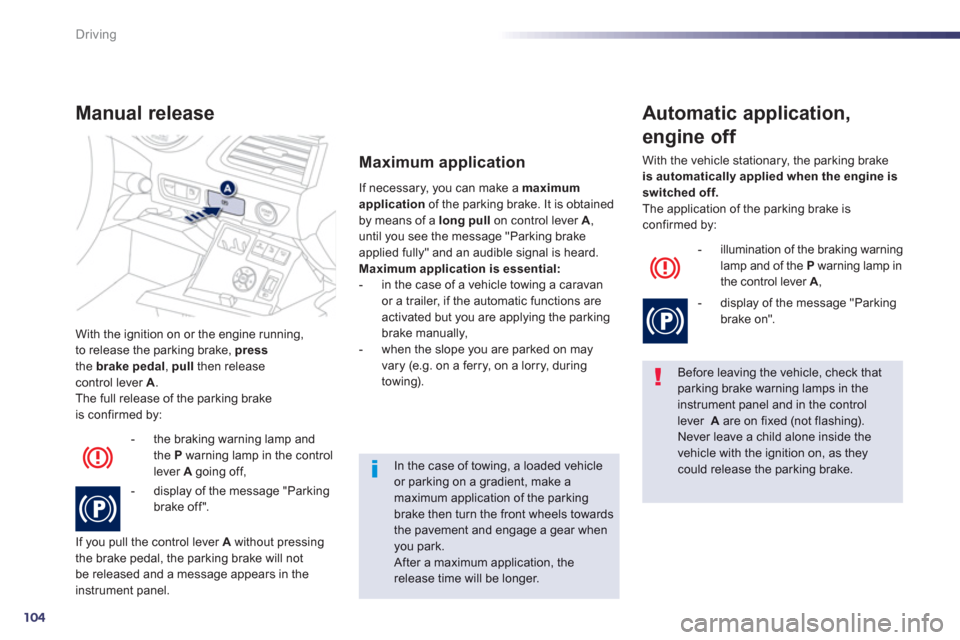
104
Driving
With the ignition on or the engine running,
to release the parking brake, pressthe brakepedal
, pullthen releasecontrol lever A
.
The full release of the parking brake
is confirmed by:
Manual release
- the braking warning lamp and
the P warning lamp in the controllever A
going off,
- displa
y of the message "Parking brake off".
I
f you pull the control lever Awithout pressing
the brake pedal, the parking brake will not
be released and a message appears in the
instrument panel. If necessar
y, you can make a maximum
applicationof the parking brake. It is obtained by means of a long pullon control lever A,
until you see the message "Parking brake
applied fully" and an audible signal is heard.Maximum application is essential:
- in the case of a vehicle towing a caravanor a trailer, if the automatic functions are
activated but you are applying the parkingbrake manually,
- when the slope you are parked on mayvary (e.g. on a ferry, on a lorry, during
towing).
Maximum application
Before leaving the vehicle, check that parking brake warning lamps in the instrument panel and in the control lever A
are on fixed (not flashing).
Never leave a child alone inside thevehicle with the ignition on, as they could release the parking brake.
Automatic application,
engine off
- illumination of the braking warning
lamp and of the Pwarning lamp in
the control lever A ,
- displa
y of the message "Parkingbrake on".
With the vehicle stationary, the parking brake is automatically applied when the engine is
switched off. The application of the parking brake is confirmed by:
In the case of towing, a loaded vehicleor parking on a gradient, make amaximum application of the parkingbrake then turn the front wheels towards the pavement and engage a gear whenyou park.
After a maximum application, the release time will be longer.
Page 107 of 340
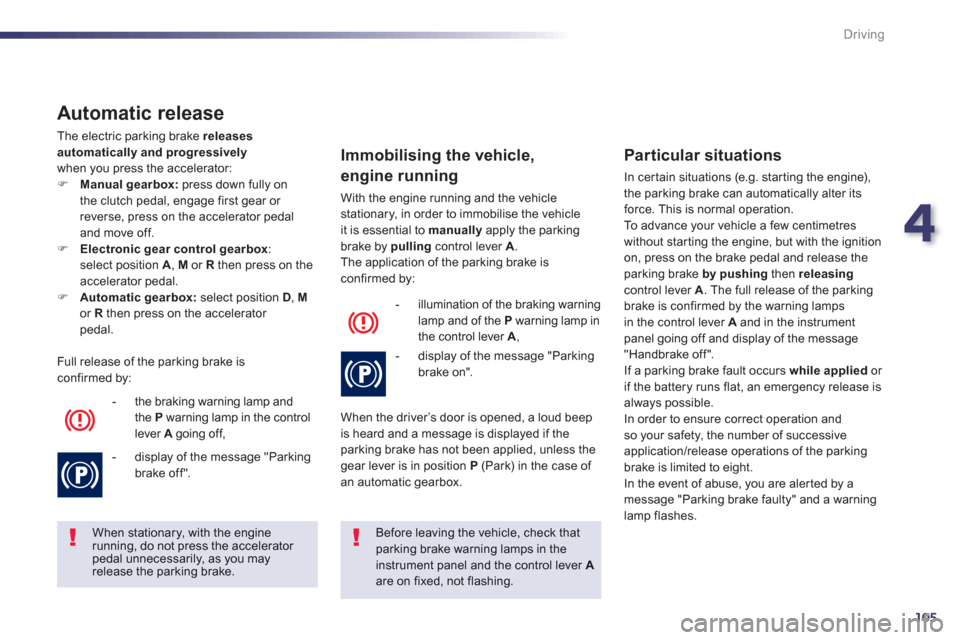
4
105
Driving
Automatic release
The electric parking brake releases automatically and progressively
when you press the accelerator:FManual gearbox:
press down fully on
the clutch pedal, engage first gear or reverse, press on the accelerator pedaland move off.FElectronic gear control gearbox : select position A
, M
or Rthen press on theaccelerator pedal. F Automatic gearbox:select position D , Mor Rthen press on the accelerator pedal.
Full release o
f the parking brake is confirmed by:
- the braking warning lamp and
th
e P warning lamp in the control
lever Agoing off, A
- display of the message "Parking brake off".
When stationary, with the engine running, do not press the accelerator pedal unnecessarily, as you may release the parking brake.
Before leaving the vehicle, check thatparking brake warning lamps in theinstrument panel and the control lever Aare on fixed, not flashing.
Immobilising the vehicle,
engine running
With the engine running and the vehicle
stationary, in order to immobilise the vehicle it is essential to manually
apply the parking
brake by pulling
control lever A.
The application of the parking brake is confirmed by:
- illumination o
f the braking warning
lamp and of the Pwarning lamp in
the control lever A ,
- displa
y of the message "Parkingbrake on".
When the driver’s door is opened, a loud beep
is heard and a message is displayed if theparking brake has not been applied, unless thegear lever is in position P (Park) in the case of an automatic gearbox.
Particular situations
In cer tain situations (e.g. star ting the engine),
the parking brake can automatically alter itsforce. This is normal operation.
To advance your vehicle a few centimetres
without star ting the engine, but with the ignition on, press on the brake pedal and release the
parking brake by pushing then releasingcontrol lever A
. The full release of the parking
brake is confirmed by the warning lamps in the control lever Aand in the instrument
panel going off and display of the message
"Handbrake off".
If a parking brake fault occurs while appliedor
if the battery runs flat, an emergency release is
always possible.
In order to ensure correct operation and
so your safety, the number of successive
application/release operations of the parking brake is limited to eight.
In the event of abuse, you are aler ted by a
message "Parking brake faulty" and a warning
lamp flashes.
Page 108 of 340
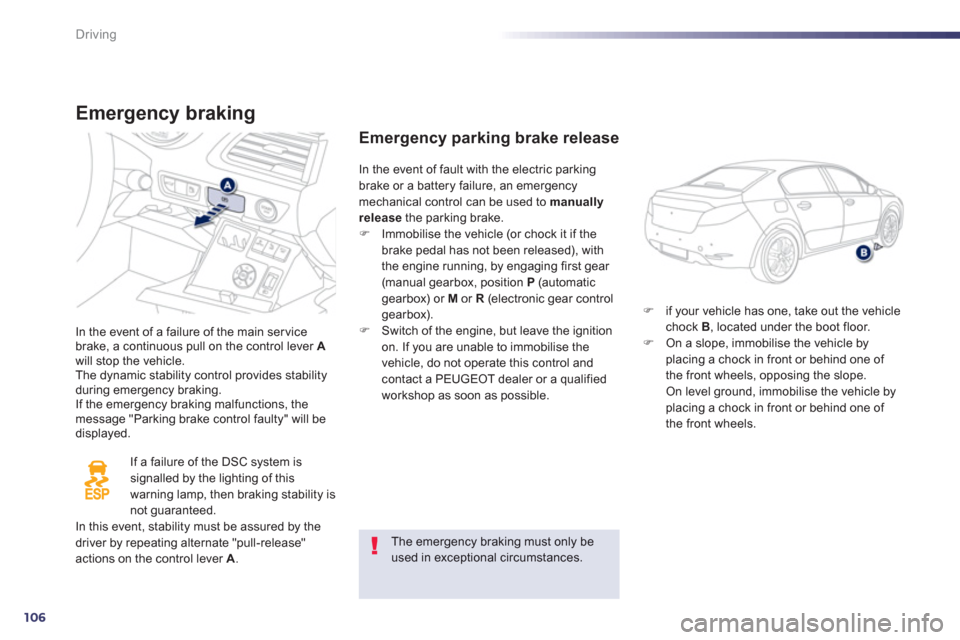
106
Driving
Emergency braking
In the event of a failure of the main servicebrake, a continuous pull on the control lever Awill stop the vehicle.The dynamic stability control provides stability during emergency braking.
If the emergency braking malfunctions, themessage "Parking brake control faulty" will be displayed.
If a failure of the DSC s
ystem is
signalled by the lighting of this
warning lamp, then braking stability is
not guaranteed.In this event, stability must be assured by thedriver by repeating alternate "pull-release" actions on the control lever A.
Emergency parking brake release
Fif your vehicle has one, take out the vehicle chock B , located under the boot floor. FOn a slope, immobilise the vehicle byplacing a chock in front or behind one of
the front wheels, opposing the slope. On level ground, immobilise the vehicle byplacing a chock in front or behind one of
the front wheels.
In the event o
f fault with the electric parkingbrake or a battery failure, an emergencymechanical control can be used to manually
releasethe parking brake.F Immobilise the vehicle (or chock it if the
brake pedal has not been released), with
the engine running, by engaging first gear (manual gearbox, position P(automatic gearbox) or M or R(electronic gear control
gearbox). F Switch of the engine, but leave the ignition on. If you are unable to immobilise the
vehicle, do not operate this control and
contact a PEUGEOT dealer or a qualified
workshop as soon as possible.
The emergency braking must only be used in exceptional circumstances.
Page 111 of 340
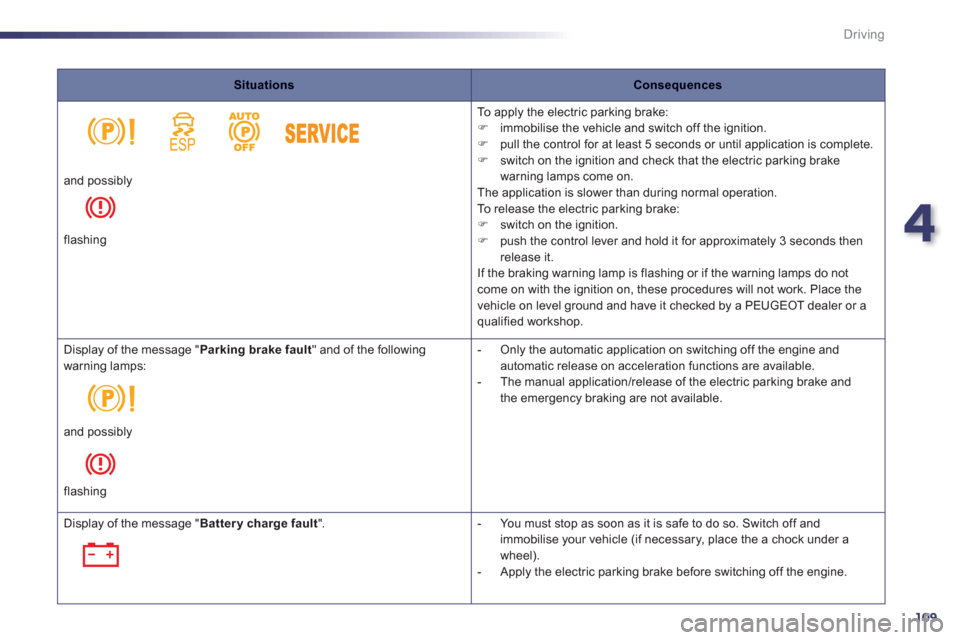
4
109
Driving
SituationsConsequences
To apply the electric parking brake: F immobilise the vehicle and switch off the ignition. F
pull the control for at least 5 seconds or until application is complete.F
switch on the ignition and check that the electric parking brake
warning lamps come on.
The application is slower than during normal operation.
To release the electric parking brake:
F
switch on the ignition. F
push the control lever and hold it for approximately 3 seconds then
release it.
If the braking warning lamp is flashing or if the warning lamps do not come on with the ignition on, these procedures will not work. Place the
vehicle on level ground and have it checked by a PEUGEOT dealer or aqualified workshop. and possibl
y
flashing
Display of the message "Parking brake fault" and of the following warning lamps:
- Only the automatic application on switching off the engine andautomatic release on acceleration functions are available.
- The manual application/release of the electric parking brake and
the emergency braking are not available.
and possibly
flashin
g
Display of the message "Battery charge fault".
- You must stop as soon as it is safe to do so. Switch off and
immobilise
your vehicle (if necessary, place the a chock under a
wheel).
- Apply the electric parking brake before switching off the engine.
Page 112 of 340
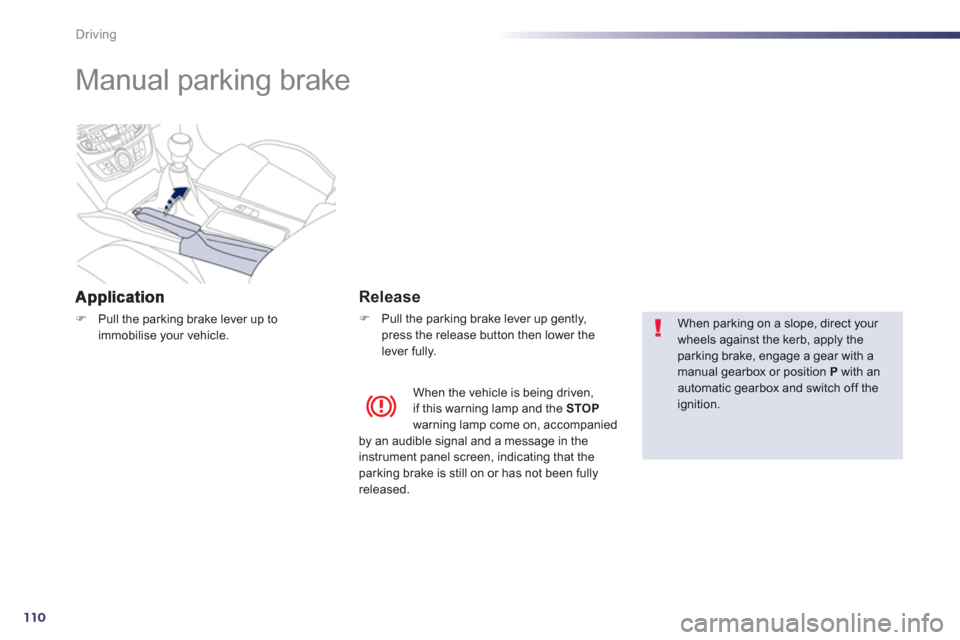
110
Driving
Manual parking brake
FPull the parking brake lever up toimmobilise your vehicle.
Release
F
Pull the parking brake lever up gently,
press the release button then lower the
lever fully.
When parking on a slope, direct your wheels against the kerb, apply theparking brake, engage a gear with amanual gearbox or position P
with an automatic gearbox and switch off theignition. When the vehicle is being driven,
if this warning lamp and the STOPwarning lamp come on, accompanied by an audible signal and a message in the
instrument panel screen, indicating that the
parking brake is still on or has not been fullyreleased.
Page 118 of 340
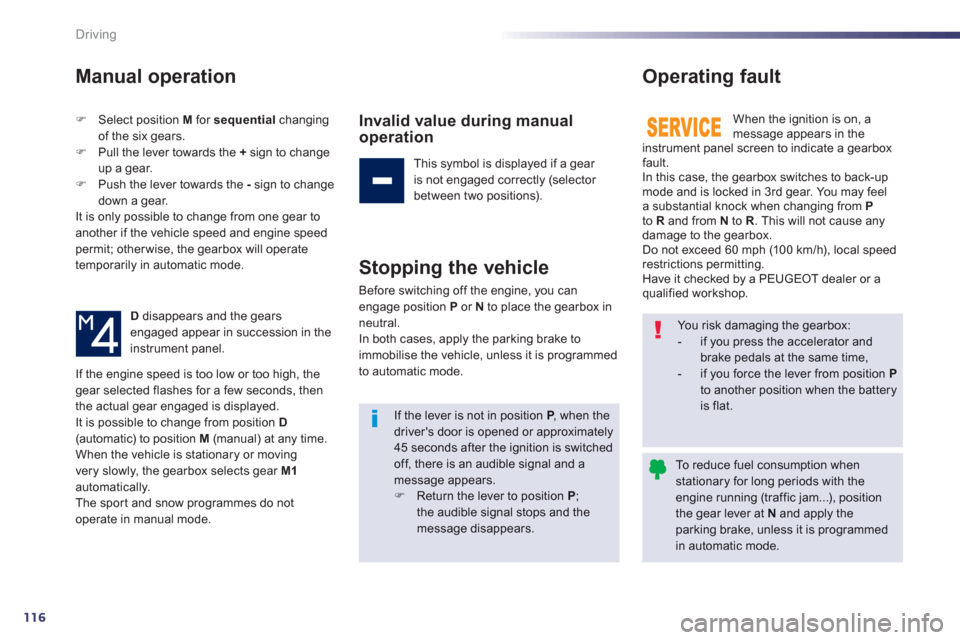
116
Driving
Manual operation
FSelect position M for sequentialchanging
of the six gears.FPull the lever towards the + sign to change
up a gear. FPush the lever towards the -
sign to change
down a gear.
It is only possible to change from one gear to another if the vehicle speed and engine speedpermit; otherwise, the gearbox will operate
temporarily in automatic mode.
D disappears and the gears engaged appear in succession in the
instrument panel.
Invalid value during manual operation
This symbol is displayed if a gear
is not engaged correctly (selector
between two positions).
Stopping the vehicle
Before switching off the engine, you can engage position P
or Nto place the gearbox in
neutral.
In both cases, apply the parking brake to
immobilise the vehicle, unless it is programmed
to automatic mode.
Operating fault
When the ignition is on, amessage appears in the
instrument panel screen to indicate a gearboxfault.
In this case, the gearbox switches to back-up mode and is locked in 3rd gear. You may feel
a substantial knock when changing from Pto Rand from N to R
. This will not cause any
damage to the gearbox.
Do not exceed 60 mph (10 0 km/h), local speed
restrictions permitting.
Have it checked by a PEUGEOT dealer or a qualified workshop.
If the en
gine speed is too low or too high, the gear selected flashes for a few seconds, then
the actual gear engaged is displayed.
It is possible to change from position D(automatic) to position M (manual) at any time.When the vehicle is stationary or movingvery slowly, the gearbox selects gear M1automatically.
The spor t and snow programmes do not
operate in manual mode.
You risk damaging the gearbox:
- if you press the accelerator and brake pedals at the same time,
- if you force the lever from position Pto another position when the batteryis flat.If the lever is not in position P
, when the Pdriver's door is opened or approximately 45 seconds after the ignition is switchedoff, there is an audible signal and a message appears. FReturn the lever to position P;the audible signal stops and themessage disappears.
To reduce fuel consumption when stationary for long periods with the engine running (traffic jam...), positionthe gear lever at Nand apply theparking brake, unless it is programmed in automatic mode.
Page 122 of 340

120
Driving
You must press the brake pedal when star ting the engine.
Whatever the circumstances, you must manually apply the parking brake when parking, unless the parking brake isprogrammed in automatic mode.
When immobilising the vehicle, with the engine running, you must place the gear lever in neutral N.Before carrying out any work in the engine compar tment, check that the
gear lever is in neutral N
and that the parking brake is applied.
Stopping the vehicle
With the ignition on, theflashing of this warning lamp, accompanied by an audiblesignal and a message in the instrument panelscreen, indicates a malfunction of the gearbox.
have it checked by PEUGEOT or a qualified
workshop. Be
fore switching off the engine, you can
choose to:
- move to position N
to engage neutral,
- leave the gear engaged; in this case, it will
not be possible to move the vehicle.
In both cases,
you must apply the parking brake to immobilise the vehicle.
Operating fault Creep function
(moving without pressing
the accelerator)
This function greatly facilitates manoeuvringof the vehicle at low speed (when parking, in a
traffic jam…).
With the engine at idle, parking brake released
and position A , M
or Rselected, the vehicle moves
as soon as you take your foot off
the brake pedal (even without pressing the accelerator pedal).
For your safety, this function is only activated
if you press the brake pedal when changing to forward drive or reverse. It is deactivated on opening the driver's door. Closing the door and then pressing the brake or accelerator pedal reactivates the function.
The vehicle does not move without pressing the accelerator pedal if the lever stays in position Nfor more than2 seconds
with the engine running,and the brake pedal is not pressed before selecting position A, M
or R
.
Never leave children inside the vehicle without supervision when the engine is running.
Page 123 of 340
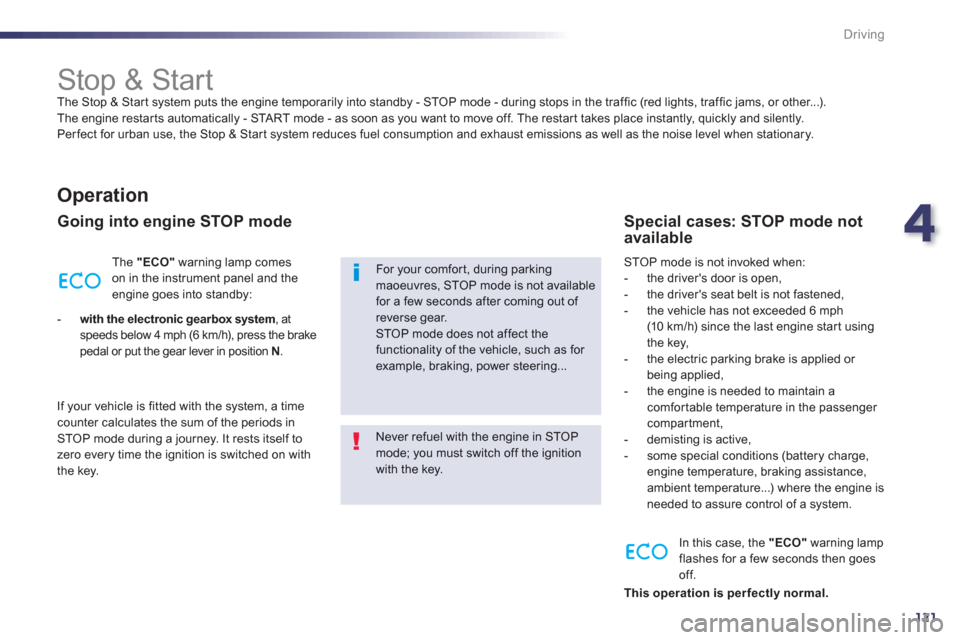
4
121
Driving
Stop & Start
The Stop & Star t system puts the engine temporarily into standby - STOP mode - during stops in the traffic (red lights, traffic jams, or other...).
The engine restar ts automatically - START mode - as soon as you want to move off. The restart takes place instantly, quickly and silently.
Per fect for urban use, the Stop & Star t system reduces fuel consumption and exhaust emissions as well as the noise level when stationary.
Operation
Going into engine STOP mode
The "ECO"warning lamp comes
on in the instrument panel and the
engine goes into standby:
-
with the electronic gearbox system, at speeds below 4 mph (6 km/h), press the brakepedal or put the gear lever in position N.
I
f your vehicle is fitted with the system, a timecounter calculates the sum of the periods in
STOP mode during a journey. It rests itself to
zero every time the ignition is switched on with
the ke
y.
Never refuel with the engine in STOPmode; you must switch off the ignition with the key.
For your comfort, during parking maoeuvres, STOP mode is not available for a few seconds after coming out of reverse gear. STOP mode does not affect the functionality of the vehicle, such as for example, braking, power steering...
Special cases: STOP mode notavailable
STOP mode is not invoked when:
- the driver's door is open,
- the driver's seat belt is not fastened,
- the vehicle has not exceeded 6 mph (10 km/h) since the last engine star t using
the key,
- the electric parking brake is applied or
being applied,
- the engine is needed to maintain acomfor table temperature in the passenger compartment,
- demisting is active,
- some special conditions (battery charge, engine temperature, braking assistance,
ambient temperature...) where the engine isneeded to assure control of a system.
In this case, the
"ECO"
warning lamp
flashes for a few seconds then goesoff.
This operation is per fectly normal
.